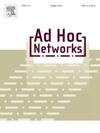UAV-Edge Cloud collaboration for online offloading and trajectory control in multi-layer Mobile Edge Computing
IF 4.8
3区 计算机科学
Q1 COMPUTER SCIENCE, INFORMATION SYSTEMS
引用次数: 0
Abstract
Integrating Mobile Edge Computing (MEC) with Unmanned Aerial Vehicles (UAVs) offers enhanced coverage and computational support for mobile IoT devices (MIDs). Due to the inherent computational capacity and energy constraints of UAV, existing UAV-assisted MEC systems struggle to satisfy computation-intensive network services for numerous MIDs. To address this issue, this paper proposes a UAV and ground-based Edge Cloud (EC) collaboration MEC system. Specifically, the EC is equipped with an energy transmitter to provide wireless power transfer (WPT) to the UAV, thereby collaboratively managing backlog tasks in scenarios where task and energy arrive stochastically. To achieve optimal service delivery, we formulate a long-term stochastic optimization problem aiming to jointly optimize UAV energy consumption and system throughput while ensuring task queue stability. However, this NP-hard problem posed by the stochastic nature of task arrivals and energy constraints, we develop an online offloading and trajectory control (OOTC) algorithm. This algorithm uses Lyapunov optimization theory to transform the long-term stochastic optimization problem into a deterministic per-slot optimization problem. The OOTC algorithm decouples control decisions across consecutive time slots, reducing computational complexity and ensuring queue stability without relying on statistical knowledge. We further decompose it into three subproblems, and derive suboptimal solutions by the Successive Convex Approximation (SCA) and the Lagrangian duality. Simulations show OOTC algorithm outperforms benchmarks and maintains stability.
多层移动边缘计算中UAV-Edge云协同在线卸载和轨迹控制
将移动边缘计算(MEC)与无人机(uav)集成为移动物联网设备(mid)提供了增强的覆盖和计算支持。由于无人机固有的计算能力和能量限制,现有的无人机辅助MEC系统难以满足众多无人机的计算密集型网络服务。为了解决这一问题,本文提出了一种无人机与地面边缘云(EC)协同的MEC系统。具体来说,EC配备了一个能量发射器,为无人机提供无线电力传输(WPT),从而在任务和能量随机到达的情况下协同管理积压任务。为了实现最优的服务交付,我们制定了一个长期随机优化问题,旨在共同优化无人机的能耗和系统吞吐量,同时保证任务队列的稳定性。然而,由于任务到达的随机性和能量约束所带来的np难题,我们开发了一种在线卸载和轨迹控制(OOTC)算法。该算法利用Lyapunov优化理论将长期随机优化问题转化为确定性逐槽优化问题。OOTC算法在不依赖统计知识的情况下解耦了连续时隙的控制决策,降低了计算复杂度并确保了队列稳定性。我们进一步将其分解为三个子问题,并利用连续凸近似和拉格朗日对偶性推导出次优解。仿真结果表明,OOTC算法优于基准测试,并保持了稳定性。
本文章由计算机程序翻译,如有差异,请以英文原文为准。
求助全文
约1分钟内获得全文
求助全文
来源期刊

Ad Hoc Networks
工程技术-电信学
CiteScore
10.20
自引率
4.20%
发文量
131
审稿时长
4.8 months
期刊介绍:
The Ad Hoc Networks is an international and archival journal providing a publication vehicle for complete coverage of all topics of interest to those involved in ad hoc and sensor networking areas. The Ad Hoc Networks considers original, high quality and unpublished contributions addressing all aspects of ad hoc and sensor networks. Specific areas of interest include, but are not limited to:
Mobile and Wireless Ad Hoc Networks
Sensor Networks
Wireless Local and Personal Area Networks
Home Networks
Ad Hoc Networks of Autonomous Intelligent Systems
Novel Architectures for Ad Hoc and Sensor Networks
Self-organizing Network Architectures and Protocols
Transport Layer Protocols
Routing protocols (unicast, multicast, geocast, etc.)
Media Access Control Techniques
Error Control Schemes
Power-Aware, Low-Power and Energy-Efficient Designs
Synchronization and Scheduling Issues
Mobility Management
Mobility-Tolerant Communication Protocols
Location Tracking and Location-based Services
Resource and Information Management
Security and Fault-Tolerance Issues
Hardware and Software Platforms, Systems, and Testbeds
Experimental and Prototype Results
Quality-of-Service Issues
Cross-Layer Interactions
Scalability Issues
Performance Analysis and Simulation of Protocols.
 求助内容:
求助内容: 应助结果提醒方式:
应助结果提醒方式:


